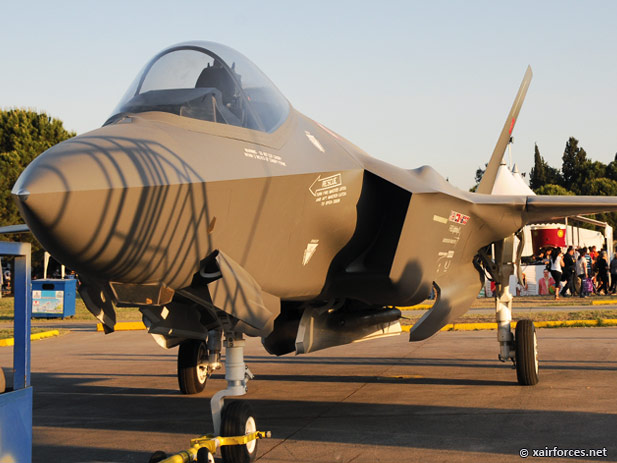
Singapore Airshow Raises Fighter Industry Stakes in Asia

The biennial 2012 Singapore Airshow, Feb. 14-19, the largest aerospace event in Asia and now among the world’s top three aviation events, will focus on regional fighter programs in Australia, Japan, Malaysia, South Korea and Taiwan.
Japan’s December decision to procure the Lockheed Martin F-35A fighter for its F-X program has given the Lightning II a boost in the region, despite reluctance within the Western market for the fighter. The $8 billion deal for 42 fighters will replace Japan’s aging Mitsubishi F-4EJ Kai Phantoms. The deal could evolve into an additional 100 to 120 F-35s to replace the Mitsubishi F-15J/DJ Eagles under the F-XX program in the middle of the decade.
The F-X program selected the F-35A over the Eurofighter Typhoon and Boeing F/A-18 Super Hornet.
South Korea has taken notice of Japan’s decision and the F-35 is seen increasingly in a favorable light, officials said. South Korea’s FX-3 fighter competition pits three fighters, the F-35A, Boeing F-15SE Silent Eagle and the Typhoon, in a $7.3 billion deal for 40 to 60 fighters. A decision is scheduled to be made in October.
Singapore is also considering the F-35 for its next fighter procurement. The nation-state is a Security Cooperative Participant member of the F-35 development program. However, officials said no decision is expected within this decade.
But the F-35 program hit a snag Down Under. Australia has just announced a review of its procurement of the F-35A and could defer the purchase until problems in the program are fixed. Australia has a requirement for up to 100 F-35A fighters, but has committed only to the first 14. Australia is a Level 2 participant in the F-35 development program.
Malaysia is debating the procurement of 10 fighters to replace MiG-29s. The Saab Gripen, Typhoon and Super Hornet are competing, but no decision is expected until after 2013.
BAE Systems and Lockheed are locking horns for the avionics upgrade and weapon systems integration on 135 KF-16C/D Block 52 fighters for the South Korean Air Force, estimated at $1 billion, and on 146 F-16A/B Block 20s for the Taiwan Air Force, estimated at $5.8 billion.
Both F-16 upgrade programs include the new Active Electronically Scanned Array (AESA) radar. AESA competitors for the refits are Northrop Grumman’s Scalable Agile Beam Radar and the Raytheon Advanced Combat Radar. Singapore is also a potential customer for the AESA for its F-16C/Ds and is watching both competitions closely.
The Jan. 31 announcement that the French Dassault Rafale defeated the Typhoon in India’s $11 billion contract for 126 fighter aircraft will spark discussion.
If Eurofighter and Boeing lose in South Korea and Malaysia, as they did in Japan and India, questions will be raised over the future of these fighters in the international market.
Airshow Attendance and Events
Despite the decline in the world economy, the biennial Singapore Airshow shows no sign of waning. This year’s airshow will be the largest to date with 900 exhibitors from more than 50 countries, including 22 country pavilions and 59 of the world’s top 100 aerospace companies, said Jimmy Lau, managing director of Experia Events, the show organizer.
“The Asia-Pacific region is riding on a wave of growth as the region continues to lead in providing new opportunities in the aerospace and defense industry,” Lau said. The Singapore Airshow is “strategically positioned as a gateway into this thriving region, [and] plays a crucial role as an effective springboard for industry players to tap into new opportunities.”
In 2010, the airshow closed with $10 billion in deals and announcements in spite of a recovering economy. This year will also feature a series of high-level conferences — the Singapore Airshow Aviation Leadership Summit and the Asia-Pacific Security Conference.
The show will have two pavilions this year focusing on new technologies: the Land Defense and Unmanned Systems Pavilion and the Green Pavilion. The Green Pavilion will feature an added component called “Deminars” or seminars and demonstrations combined, Lau said.
Airshow officials would not identify the number or types of government delegations visiting the show for security reasons, but the 2010 airshow saw 259 foreign government and international delegations from 80 countries and 43,459 trade attendees from 133 counties.
Security will be tight to safeguard delegations and exhibitors. Beyond the usual prohibited items, such as firearms and explosives, the exhaustive list includes spear guns, walking sticks with daggers, nanchakus, crossbows, spears and brass knuckles.
There will be much attention paid to Chinese exhibitors and delegations this year. Those attending the China Business Forum will hear presentations from Ng Pock Too, chairman and CEO from New Board Technology, and Zhang Xin Guo, executive vice president of the Aviation Industry Corp. of China.
Chinese companies exhibiting this year include China National Aero-Technology Import and Export Corp., Commercial Aircraft Corp. of China, AMECO Bejing and, for the first time at the show, Beijing Youtaishuncheng Technology Development Co. with a UAV exhibit.
The flying display will feature the Blair Aerosports’ Rebel 300, Singapore Air Force’s F-16 and F-15SG fighter jets, and the Royal Australian Air Force’s Roulettes flying Pilatus PC-9/A trainers. Despite rumors the F-22 Raptor would appear, Lockheed indicated the Raptor will be a no show.
Jung Sung-ki in Seoul, Paul Kallender-Umezu in Tokyo and Nigel Pittaway in Melbourne, Australia, contributed to this report.
Source: By WENDELL MINNICK, TAIPEI, 09 February 2012 - Gannett Government Media / DefenceNews (www.defensenews.com)
Photo: Lockheed Martin F-35 fighter jet at the Singapore Airshow in 2012 (Photo by © xairforces.net 2012)
(9.02.2012)
|